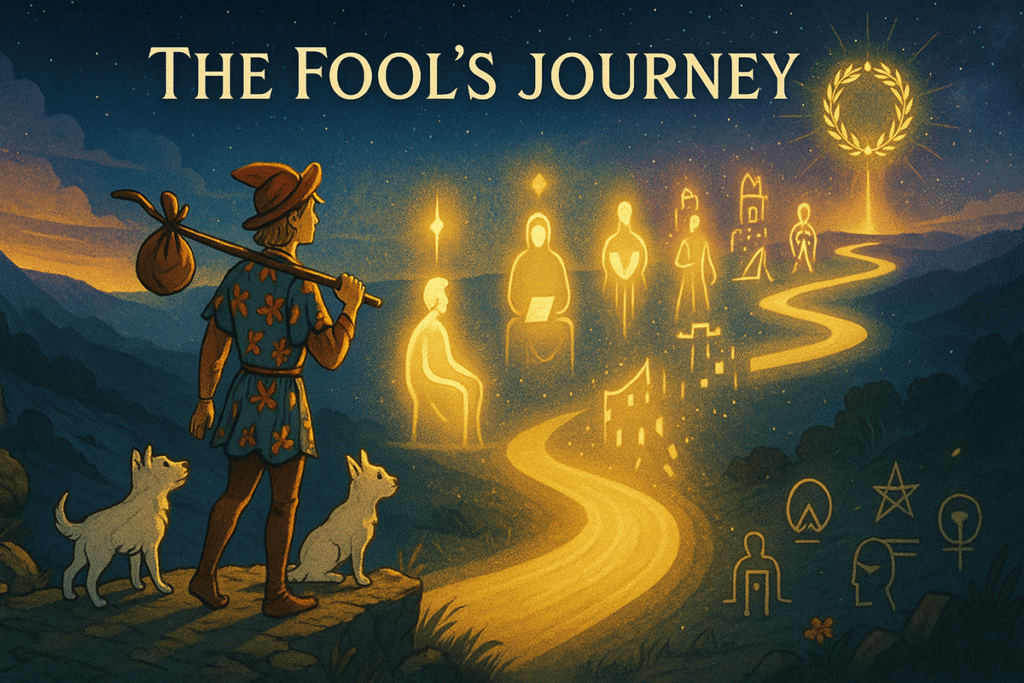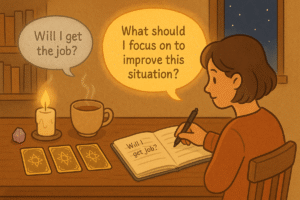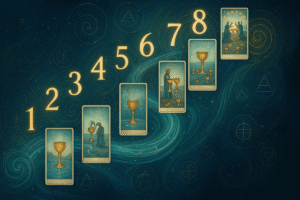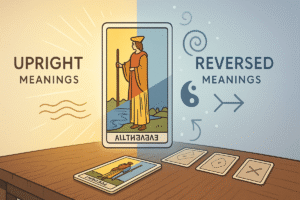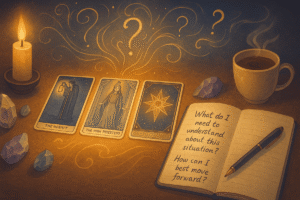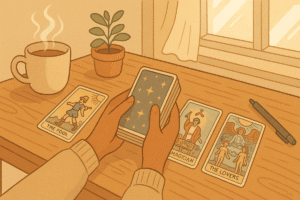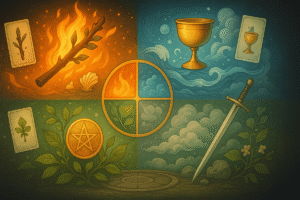Table of Contents
Have you ever wondered if there’s a deeper story hidden within the tarot deck? Perhaps you’ve felt drawn to the Major Arcana cards without fully understanding why they seem to speak to something profound within you. The concept known as The Fool’s Journey offers one of the most compelling ways to explore these archetypal images as a connected narrative of human experience and personal development.
Understanding The Fool’s Journey Framework
The Fool’s Journey presents the 22 Major Arcana cards as chapters in a single, continuous story. This narrative begins with The Fool (card 0), representing the innocent soul at the beginning of life’s adventure, and concludes with The World (card 21), symbolizing completion, integration, and the achievement of wholeness.
What makes this framework particularly fascinating is how it mirrors the universal patterns of growth we all experience. Think about your own life for a moment. Haven’t you noticed certain themes that seem to repeat? Times of innocence followed by learning, periods of struggle that lead to wisdom, moments of loss that eventually transform into understanding?
The journey isn’t meant to be taken as a literal prediction of what will happen in your life. Instead, it serves as a mirror for reflection. When you consider where you might be in your own personal journey, which archetypal energy feels most relevant to your current experiences?
The Three Acts of Personal Development
Many tarot enthusiasts find it helpful to think of The Fool’s Journey in three distinct acts, though I should mention that different sources sometimes organize this differently. The beauty lies in how you personally connect with the narrative structure.
The First Act: Awakening and Discovery
The opening phase typically encompasses The Fool through The Chariot (cards 0-7). These cards often represent the initial stages of self-awareness and the development of personal will. The Fool steps forward with pure potential, encounters The Magician’s focused intention, receives wisdom from The High Priestess, and learns about nurturing from The Empress.
What strikes me about this section is how it reflects those early moments when we first begin to understand ourselves as separate individuals. Perhaps you can remember times in your own life when you felt that mix of excitement and uncertainty that The Fool embodies? Or moments when you needed to channel The Magician’s focused determination to make something happen?
The Hierophant introduces questions about tradition and learning from established systems, while The Lovers presents choices about relationships and values. The Chariot suggests the culmination of this phase, where willpower and determination create forward momentum.
The Second Act: Challenges and Inner Work
The middle section, often considered to span from Strength through Temperance (cards 8-14), delves into deeper psychological and spiritual territory. This is where the journey becomes more complex and, frankly, more challenging.
Strength asks us to consider how we might work with our inner nature rather than against it. The Hermit invites periods of solitude and self-examination. The Wheel of Fortune reminds us that change is constant, while Justice encourages reflection on balance and consequences.
I find The Hanged Man particularly intriguing in this sequence. It suggests that sometimes growth requires us to suspend our usual way of seeing things. Have you ever experienced a period where everything felt upside down, only to later realize it was exactly what you needed for a new perspective to emerge?
Death and Temperance continue this theme of transformation and integration. These cards don’t predict literal events but rather invite contemplation about what might need to change or find better balance in your life.
The Third Act: Integration and Completion
The final phase, from The Devil through The World (cards 15-21), addresses themes of liberation, revelation, and ultimate integration. This section often feels the most intense because it deals with shadow work, sudden insights, and the final steps toward wholeness.
The Devil might represent whatever feels like it has power over you, while The Tower suggests those moments when old structures crumble to make way for something new. The Star offers hope and spiritual connection, and The Moon acknowledges the mysterious, intuitive aspects of existence.
The Sun brings clarity and joy, while Judgement calls for reflection on personal rebirth or awakening. Finally, The World represents the integration of all previous experiences into a sense of completion and fulfillment.
Personal Reflection and The Journey
One thing I’ve noticed about The Fool’s Journey is that it doesn’t necessarily unfold in a neat, linear progression. Life rarely works that way, does it? You might find yourself cycling back through certain archetypal energies multiple times, or experiencing several simultaneously.
The real value seems to lie in using this framework as a tool for self-reflection. When you’re facing a particular challenge or transition, you might ask yourself: What archetype feels most relevant right now? What questions is this experience asking me to consider?
For instance, if you’re feeling stuck in a situation, The Hanged Man’s energy might offer insights about the value of patience and seeing things from a different angle. If you’re dealing with a major life change, The Tower’s symbolism could help you reflect on what structures in your life might be ready for transformation.
Working With The Journey in Daily Life
Some people enjoy journaling with The Fool’s Journey as a framework, using it to examine their personal growth patterns. Others find it helpful for understanding relationships, career transitions, or creative projects. The key is remembering that this is a tool for introspection, not prediction.
You might try reflecting on which card currently resonates most with your life circumstances. What questions does that archetype invite you to explore? How might its energy guide your thinking about current challenges or opportunities?
Perhaps start by considering The Fool’s innocent curiosity. What would it feel like to approach a current situation with fresh eyes, free from assumptions about how things “should” be? Or think about The Hermit’s wisdom. What inner knowledge might you be overlooking in your rush to find external solutions?
The Journey as Metaphor
What makes The Fool’s Journey particularly compelling is its function as a metaphor for the universal human experience. We all begin with innocence, face challenges that test our resolve, encounter teachers and obstacles, experience loss and renewal, and hopefully move toward greater wisdom and integration.
The beauty of this framework lies not in its ability to predict the future, but in its capacity to help us reflect on the present. It offers a language for examining our experiences and a structure for understanding growth as a natural, ongoing process.
Sometimes I wonder if the real magic of The Fool’s Journey isn’t in the cards themselves, but in how it encourages us to see our lives as meaningful narratives rather than random series of events. When we frame our experiences within archetypal patterns, we might discover deeper connections and purposes than we initially recognized.
Embracing Your Personal Journey
As you explore The Fool’s Journey, remember that your interpretation and experience are uniquely yours. The same card might speak to different people in entirely different ways, and that’s not only okay but expected. The framework provides structure, but your personal insights and reflections breathe life into that structure.
Consider keeping a journal as you explore these concepts. What patterns do you notice in your own life that mirror the archetypal journey? Which energies feel familiar, and which feel foreign or challenging? How might this framework offer new perspectives on past experiences or current circumstances?
The Fool’s Journey ultimately invites us to see life itself as a sacred adventure of growth and discovery. Whether you’re at the beginning of a major transition or in the middle of integrating recent changes, this archetypal map offers a way to honor both your struggles and your growth.
The next time you encounter one of the Major Arcana cards, perhaps in a reading or even in artwork, you might pause to consider where you are in your own fool’s journey. What questions is life asking you to explore right now? What archetype might offer wisdom for your current path?
After all, we’re all fools in the best possible sense, stepping forward into unknown territory with courage, curiosity, and the hope that each experience will teach us something valuable about who we’re becoming.
Frequently Asked Questions
Do I need to experience The Fool’s Journey in order?
No, life rarely unfolds in a neat linear sequence, and neither does your personal journey through these archetypes. While the cards are numbered 0 through 21, you might find yourself cycling back to earlier energies or experiencing several stages simultaneously. Think of it more as a spiral than a straight line, where you revisit similar themes at deeper levels of understanding as you grow.
Can I use The Fool’s Journey with just the Major Arcana cards?
Absolutely! Many people find it helpful to work with only the 22 Major Arcana cards when exploring The Fool’s Journey. You might pull a single card to reflect on where you are in your current life phase, or lay out several cards to contemplate different aspects of your personal development. This focused approach can make the archetypal themes easier to connect with and understand.
Is The Fool’s Journey the same as the Hero’s Journey?
They share remarkable similarities as both describe a universal pattern of growth and transformation. Joseph Campbell’s Hero’s Journey and The Fool’s Journey through the tarot both map out stages of departure, initiation, and return. However, The Fool’s Journey uses 22 specific archetypal images rather than a narrative structure, and it emphasizes personal reflection over external adventure. Think of them as different languages describing the same human experience.
What if I draw a card that doesn’t seem to match my current situation?
Cards can speak to us in unexpected ways. A card that seems unrelated at first might be inviting you to consider a perspective you haven’t explored yet, or it could be highlighting an undercurrent in your life that you haven’t fully acknowledged. Rather than dismissing it, ask yourself what questions that particular archetype might be encouraging you to explore. Sometimes the cards we resist most are the ones with the most valuable insights to offer.

